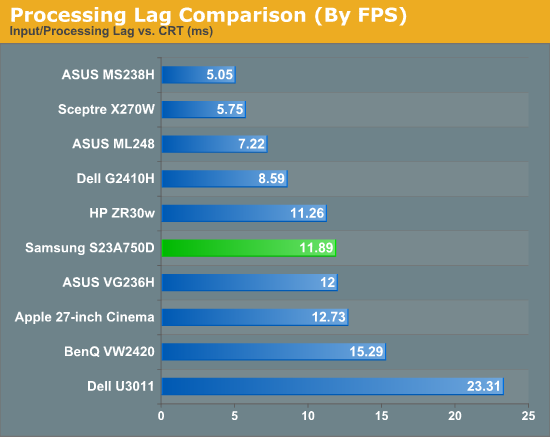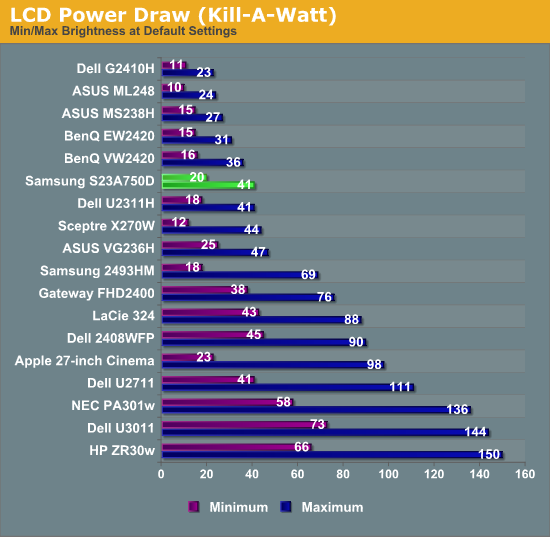Samsung S23A750D 3D LCD Display
by Chris Heinonen on December 17, 2011 2:45 PM ESTSamsung S23A750D Lag and Power Usage
Measuring lag on the Samsung was much easier than most panels. Typically when taking shots of an LCD next to a CRT monitor, the FPS numbers on the LCD will be blurry in a shot at least half the time. This is since we’re running at 60Hz and only shooting at 3-4 times that rate, so often we are between frames. With the 120Hz rate of the Samsung, almost all of my images were sharp and clear, which made this bench test much easier than usual.

Our overall lag would typically be less than 1 frame, since we usually deal with a 60Hz LCD, but in this case it was just over 1 frame since it is a 120Hz display. This is still a little better than most displays, and the faster refresh means that even if you have a frame of lag, that next frame is coming twice as fast as it would with a typical 60Hz display, so the effect should feel like less. I also tried to increase the response time of the display through the menu but had no change in the lag results.
The power use of the Samsung was a bit higher than a normal LCD, though this could easily be due to the 120Hz refresh rate that uses more power. Samsung doesn’t make a 60Hz version so there’s no way to check for certain that it’s the cause of the use. The power use was still very reasonable for the display size.











80 Comments
View All Comments
sviola - Monday, December 19, 2011 - link
Well, I hope it doesn't take much longer. Also, I hope they'll release them with 16:10 aspect ratio.DanNeely - Monday, December 19, 2011 - link
It'd be nice if they manage to get top flight LED backlight color accuracy above that of top flight CFL models before the 120hz refresh too.MadAd - Sunday, December 25, 2011 - link
This is my problem too.I have a triple desktop including x2 1920x1200 IPS screens. Any new 120hz monitor has to fit in, in the center, 1080 isnt going to work.
Why cant we get
-120hz
-displayport
-1200 lines
in one package? I could even wait for IPS, but the aspect ratio is a dealbreaker.
MadAd - Sunday, December 25, 2011 - link
-24"(forgot that one)
The only one ive seen even close is that horrible shape one for an insane amount of money
dingetje - Saturday, December 17, 2011 - link
screw that 16:9 paneli need vertical space....not horizontal space....i don't need a television, i need a pc screen
mac2j - Sunday, December 18, 2011 - link
I have a S27A950D, which is pretty much the same panel but 27". I actually have been pleased with the interface and have had no problems with it - although perhaps the buttons are more spaced on the 27"?The picture is amazing and I can't imagine buying another monitor that isn't at least 120hz - its not just the smooth motion and drag, etc - it's hard to describe how good and crisp the picture on this monitor really is. I have a really nice 240hz TV in the same room and if I play a Blu-ray and mirror it on the 2 screens it looks noticeably better on the monitor - better colors, better color depth, better blacks, brighter ... just all around an amazing monitor.
It would be nice if we could get a 2560 x 1440 monitor at 120hz ... which i think Displayport could handle rather than having to choose between the 850D which is 2560 x 1440 or the 950 which is 1080p but 120hz.
wtfbbqlol - Sunday, December 18, 2011 - link
I don't think an LCD's response time is dependent on phosphors.PrinceGaz - Sunday, December 18, 2011 - link
Quite correct. And the response-time of phosphors has never been an issue anyway as every CRT display used them and they could have a near instant response time.AnandTech is certainly going downhill these days.
If Anand reads these comments, he should seriously consider the quality of the reviews being posted on his site, as the quality is becoming increasingly variable, from superb articles which delve into new CPU micro-architecture, to pot-boilers like this which consist mainly of recycled previous stuff combined with the author's own input which is of very dubious quality.
Zan Lynx - Monday, December 19, 2011 - link
CRT phosphors were always an issue in multisync monitors.The issue is that the phosphor had to be chosen so that its persistence matched the refresh rate.
If it lasted too long there would be ghosting. If it was too short the image would flash and cause eye strain.
This was a big problem with CRTs designed for a 75Hz refresh. Running them at 60Hz was pretty awful, yet lots of people did that anyway.
ggathagan - Monday, December 19, 2011 - link
All true, but the overarching point is that LCD screens don't involve phosphor, hence the complaint.